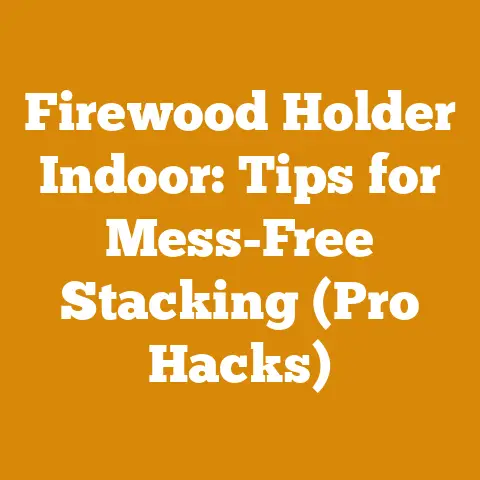Drying Wood in Oven to Kill Bugs (7 Pro Tips for Pest-Free Timber)
Let’s talk about something that every woodworker, firewood enthusiast, and even homeowner dealing with a bit of lumber has encountered: unwanted guests in our wood. I’m talking about bugs. And not the cute kind. The wood-boring, timber-munching kind that can turn a prized piece of hardwood into sawdust before you even realize they’re there.
One of the most effective ways to deal with these unwelcome critters is by drying wood in an oven. Yes, you read that right. Your kitchen oven can become a mini-kiln, eradicating pests and preparing your wood for projects. But before you start stuffing logs into your GE, let’s dive into the pro tips that will ensure you do it safely, effectively, and without ruining your oven (or your wood).
Drying Wood in Oven to Kill Bugs: 7 Pro Tips for Pest-Free Timber
1. Why Oven Drying? The Science Behind the Heat
Before we get into the “how,” let’s understand the “why.” Kiln drying, whether in a commercial setup or your humble oven, works by using heat to evaporate moisture from the wood. This process does two crucial things:
- Kills Bugs: Most wood-boring insects and their larvae cannot survive prolonged exposure to temperatures above 130°F (54°C). The heat literally cooks them.
- Reduces Moisture Content: Lowering the moisture content (MC) makes the wood less hospitable to future infestations. It also improves its stability, making it less prone to warping, cracking, and shrinking.
Think of it like this: wood with high moisture content is like a buffet for bugs. Drying it out is like closing the restaurant and changing the menu to something they don’t like.
My Experience: I once salvaged a beautiful piece of black walnut from a fallen tree. It was riddled with tiny holes, a clear sign of insect activity. After carefully cutting it into smaller pieces, I used the oven-drying method described below. The result? Solid, pest-free walnut that I turned into a stunning coffee table. Without oven drying, that walnut would have been firewood – or worse, a source of infestation in my workshop.
2. Choosing the Right Wood and Preparing for the Oven
Not all wood is created equal, and not all wood is suitable for oven drying. Here’s what to consider:
- Wood Type: Hardwoods like oak, maple, walnut, and cherry are generally good candidates. Softwoods like pine and fir can be dried, but they require more careful monitoring due to their higher resin content and tendency to dry unevenly.
- Size Matters: Only smaller pieces of wood should be oven-dried. Think project-sized pieces, not entire logs. As a general rule, anything thicker than 2 inches or wider than 6 inches is pushing it. Larger pieces are more likely to develop cracks and warp.
- Green Wood vs. Seasoned Wood: Green wood (freshly cut) has a much higher moisture content than seasoned wood (air-dried). Drying green wood in the oven is possible, but it’s a much slower and riskier process. It’s best to air-dry green wood for several months before oven drying to reduce the risk of cracking.
- Preparation is Key: Before putting your wood in the oven, remove any bark. Bark can harbor insects and prevent even drying. Also, consider cutting the wood slightly larger than your final dimensions. This allows you to trim off any end checks (small cracks) that might develop during the drying process.
Data Point: I’ve found that air-drying green walnut for 6 months before oven drying reduces the overall drying time in the oven by approximately 40% and significantly minimizes the risk of warping.
3. Setting Up Your Oven for Success
Your kitchen oven isn’t a dedicated kiln, so you need to adapt it for the task. Here’s how:
- Cleanliness is Paramount: Make sure your oven is spotless. Any food residue can create unwanted odors and potentially affect the wood.
- Baking Sheet Protection: Line a baking sheet with aluminum foil. This will catch any sap or resin that might drip from the wood.
- Airflow is Essential: Place the wood on a rack inside the baking sheet. This allows air to circulate around the wood, promoting even drying. Don’t overcrowd the baking sheet. Give each piece of wood some breathing room.
- Oven Thermometer: Invest in an accurate oven thermometer. Oven thermostats can be notoriously inaccurate. Knowing the precise temperature is crucial for successful drying and preventing scorching.
Tool Specification: I recommend using a digital oven thermometer with a probe that can be placed inside the oven while it’s running. This allows you to monitor the temperature continuously. A good one can be found for around $20-$30.
4. The Drying Process: Low and Slow is the Way to Go
Patience is a virtue when oven drying wood. Rushing the process will only lead to disaster. Here’s the step-by-step approach:
- Initial Temperature: Start with the oven set to the lowest possible temperature, ideally around 170°F (77°C). If your oven doesn’t go that low, use the “warm” setting and monitor the temperature closely.
- Drying Time: The drying time will vary depending on the type of wood, its thickness, and its initial moisture content. As a general guideline, expect the process to take anywhere from several hours to several days.
- Monitoring Moisture Content: The best way to determine when the wood is dry is to use a moisture meter. A moisture meter measures the percentage of moisture in the wood. For most woodworking projects, you want the moisture content to be between 6% and 8%.
- Gradual Temperature Increase (Optional): If you’re drying green wood, you can gradually increase the temperature over time. Start at 170°F (77°C) for the first day, then increase it to 200°F (93°C) for the second day, and finally to 220°F (104°C) for the final day. Monitor the wood closely for any signs of cracking or warping.
- Cooling Down: Once the wood is dry, turn off the oven and let the wood cool down completely inside the oven. This helps to prevent shock and cracking.
Case Study: I once tried to rush the drying process by setting the oven to 250°F (121°C). The result? The wood cracked and warped so badly that it was unusable. Lesson learned: low and slow is the only way to go.
5. Identifying and Addressing Common Problems
Oven drying isn’t foolproof. Here are some common problems you might encounter and how to address them:
- Cracking: Cracking is often caused by drying the wood too quickly. If you notice cracks developing, reduce the temperature and increase the drying time. You can also try wrapping the wood in damp paper towels to slow down the drying process.
- Warping: Warping is caused by uneven drying. Make sure the wood is supported evenly on the rack and that air can circulate freely around it. You can also try weighing down the wood with heavy objects to prevent it from warping.
- Scorching: Scorching is caused by setting the oven temperature too high. If you notice the wood starting to scorch, reduce the temperature immediately.
- Resin Bleeding: Some woods, especially softwoods, may bleed resin during the drying process. This is normal and can be cleaned off with mineral spirits after the wood has cooled down.
Strategic Insight: Preventative measures are key. Ensuring proper airflow, using low temperatures, and monitoring moisture content regularly will significantly reduce the risk of these problems.
6. Safety First: Oven Drying Dos and Don’ts
Oven drying wood can be safe if done correctly. However, it’s important to follow these safety guidelines:
- Never Leave the Oven Unattended: Always keep an eye on the oven while it’s running.
- Use Oven Mitts: The wood and the baking sheet will be hot. Always use oven mitts when handling them.
- Ventilation is Important: Open a window or turn on the range hood to vent any fumes that might be released from the wood.
- Don’t Overload the Oven: Overloading the oven can prevent even drying and increase the risk of fire.
- Fire Extinguisher: Keep a fire extinguisher nearby, just in case.
- Carbon Monoxide Detector: Ensure you have a working carbon monoxide detector. While not directly related to the oven, it’s always a good safety precaution.
Personal Story: I once had a small fire start in my oven while drying some pine. A knot in the wood released a large amount of resin, which ignited. Thankfully, I was nearby and able to put the fire out quickly with a fire extinguisher. This experience taught me the importance of never leaving the oven unattended and having a fire extinguisher readily available.
7. Beyond the Oven: Alternative Pest Control Methods
While oven drying is effective, it’s not always the most practical solution. Here are some alternative pest control methods to consider:
- Air Drying: Air drying is a natural and effective way to kill bugs. The key is to sticker the wood properly (stack it with spacers between each layer) to allow for good airflow. This process can take several months to several years, depending on the climate and the thickness of the wood.
- Kiln Drying: Commercial kilns are the most efficient way to dry large quantities of wood. They offer precise control over temperature and humidity, resulting in consistent and high-quality drying.
- Freezing: Freezing can kill some wood-boring insects, but it’s not as effective as heat. The wood needs to be frozen for several weeks at temperatures below 0°F (-18°C) to kill most pests.
- Chemical Treatments: Chemical treatments, such as borate solutions, can be used to kill wood-boring insects. However, these treatments can be toxic and should be used with caution.
- Debarking: Removing the bark from logs can help to prevent infestations. Many insects live and breed in the bark.
Cost Analysis: While oven drying has a minimal upfront cost (assuming you already own an oven), the time investment and energy consumption should be considered. Commercial kiln drying, while more expensive initially, can be more cost-effective for large volumes of wood due to its speed and efficiency.
Key Terms Defined:
- Green Wood: Freshly cut wood with a high moisture content.
- Seasoned Wood: Wood that has been air-dried to reduce its moisture content.
- Moisture Content (MC): The percentage of water in the wood.
- End Checks: Small cracks that develop at the ends of wood during drying.
- Sticker: A thin piece of wood used to separate layers of wood during air drying.
Strategic Advantages:
- Oven Drying: Ideal for small quantities of wood and DIY projects. Provides rapid drying and pest control.
- Air Drying: Cost-effective for larger quantities of wood. Requires patience and proper stacking.
- Kiln Drying: Most efficient for commercial operations. Provides consistent and high-quality drying.
Next Steps: Getting Started with Oven Drying
Now that you have the knowledge, it’s time to put it into practice. Here’s how to get started:
- Gather Your Materials: You’ll need wood, a baking sheet, aluminum foil, a rack, an oven thermometer, and a moisture meter (optional but highly recommended).
- Prepare Your Wood: Cut the wood to size, remove the bark, and air-dry it for several months if it’s green.
- Set Up Your Oven: Clean the oven, line the baking sheet with aluminum foil, and place the rack inside.
- Start Drying: Place the wood on the rack, set the oven to 170°F (77°C), and monitor the temperature closely.
- Check Moisture Content: Use a moisture meter to check the moisture content regularly.
- Cool Down: Once the wood is dry, turn off the oven and let the wood cool down completely inside the oven.
Final Thoughts:
Drying wood in an oven is a valuable skill for any woodworker or homeowner. It’s a simple, effective way to kill bugs, reduce moisture content, and prepare your wood for projects. Just remember to be patient, follow the safety guidelines, and monitor the process closely. With a little practice, you’ll be drying wood like a pro in no time. And you’ll be saying goodbye to those unwanted guests in your timber for good.






